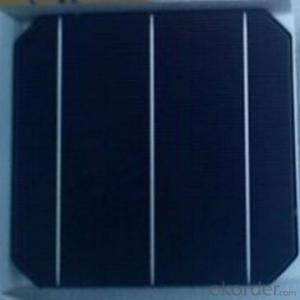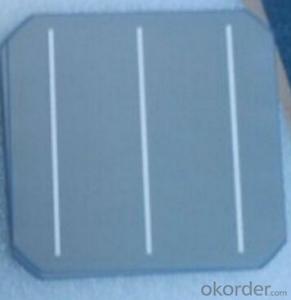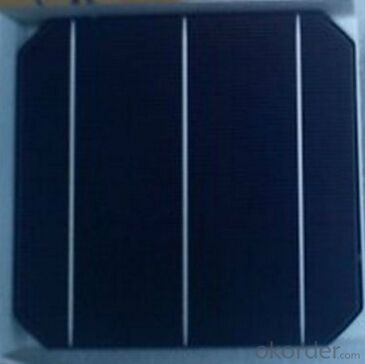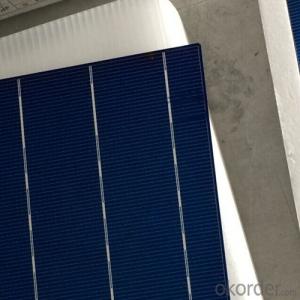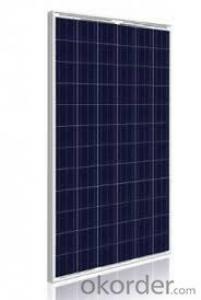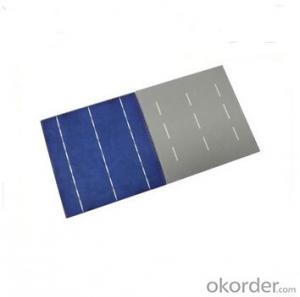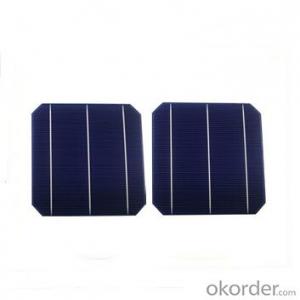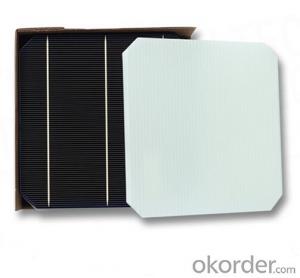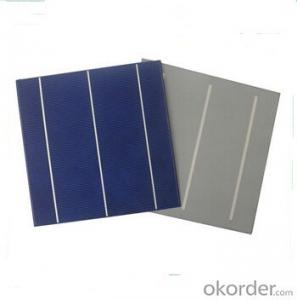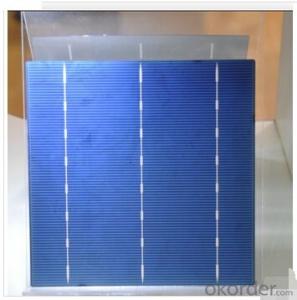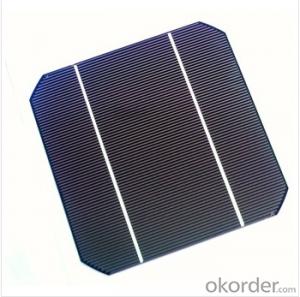Plant Based Monocrystalline Solar Cells Series-- 18.2%
- Loading Port:
- Shanghai
- Payment Terms:
- TT OR LC
- Min Order Qty:
- 1000 pc
- Supply Capability:
- 100000 pc/month
OKorder Service Pledge
OKorder Financial Service
You Might Also Like
Solar Cells:
Solar cells is made by solar wafer, it has three categories of solar cell right now, monocrystalline polycrystalline and thin film,These cells are entirely based around the concept PNjunction, which is the critical part of solar module, it is the part that can convert the light energy into electricity, the thickness is from 180um to 200um, with even busbars to conduct electricity, textured cell can decrease diffuse reflection; they are often electrically connected and encapsulated as a module. Photovoltaic modules often have a sheet of glass on the front (sun up) side, allowing light to pass while protecting semiconductor wafers from abrasion and impact due to wind-driven debris, rain, hail, etc. Solar cells are also usually connected in series in modules, creating an additive voltage. Connecting cells in parallel will yield a higher current;With high quality and stable quality. Our Cells can greatly improve the performance of Solar Modules.
Features:
High conversion efficiencies resulting in superior power output performance.
Outstanding power output even in low light or high temperature conditions
Optimized design for ease of soldering and lamination
Long-term stability,reliability and performance
Low breakage rate
Color uniformity
Specifications:
Dimension: 156mm±0.5mm
Wafer Thickness: 200μm±20μm
Diagonal: 200mm±1.0mm(round chamfers)
Front: 1.5mm Silver bus bars; Blue/others silicon nitride antireflection coating
Back: 3.0mm Silver bus bars; Full-surface aluminum BSF
Efficiency | Efficiency | Pmax(W) | Average | Impp(A) | Vmpp(V) | Isc(A) | Voc(V) |
1840 | 18.30-18.50 | >4.371 | >4.371 | 8.285 | 0.530 | 8.695 | 0.626 |
1820 | 18.10-18.30 | 4.323-4.371 | 4.347 | 8.245 | 0.528 | 8.662 | 0.626 |
1800 | 17.90-18.10 | 4.276-4.323 | 4.299 | 8.190 | 0.526 | 8.630 | 0.625 |
1780 | 17.70-17.90 | 4.228-4.276 | 4.252 | 8.140 | 0.524 | 8.621 | 0.624 |
1760 | 17.50-17.70 | 4.180-4.228 | 4.204 | 8.095 | 0.522 | 8.598 | 0.623 |
1740 | 17.30-17.50 | 4.132-4.180 | 4.156 | 8.045 | 0.520 | 8.568 | 0.622 |
1720 | 17.10-17.30 | 4.085-4.132 | 4.108 | 7.905 | 0.518 | 8.528 | 0.620 |

Solar Cells Advantage:
• High efficiency and stable performance in photovoltaic conversion.
• Advanced diffusion technique ensuring the homogeneity of energy conversion efficiency of the cell.
• Advanced PECVD film forming, providing a dark blue silicon nitride anti-reflection film of homogenous color and attractive appearance.
• High quality metal paste for back surface and electrode, ensuring good conductivity, high pulling strength and ease of soldering.
FAQ
We have organized several common questions for our clients,may help you sincerely:
①What price for each watt?
It depends on the efficiency of the solar cell, quantity, delivery date and payment terms.
②How long can we receive the product after purchase?
In the purchase of product within three working days, We will arrange the factory delivery as soon as possible. The pecific time of receiving is related to the state and position of customers.Commonly 7 to 10 working days can be served.
③Can you provide the peripheral products of the solar panels, such as the battery, controller, and inverter? If so, can you tell me how do they match each other?
Yes, we can, we have two companies for solar region, one is CNBM International, the other is CNBM engineering Co.
We can provide you not only the solar module but also the off grid solar system, we can also provide you service with on grid plant.
④What is your warranty of solar cell?
Our product can promise lower than 0.3% open box crack, we support claim after opening the box if it has crackm color difference or sth, the buyer should give pictures immediately, we can not accept the claim after the solar cell has assembled to solar panel.
• Timeliness of delivery
• ⑤How do you pack your products?
We have rich experience on how to pack the solar cell to make sure the safety on shipment, we could use wooden box or pallet as buyer's preference.
- Q: How are solar cells used in spacecraft?
- Solar cells are used in spacecraft to convert sunlight into electricity, providing power to the various systems and instruments on board.
- Q: What are the advantages and disadvantages of solar panels and diodes?
- If it is parallel in the positive and negative, then the protective effect, the diode is connected to the negative power supply, the diode negative connected to the positive power supply.
- Q: Can solar cells be used in portable devices?
- Yes, solar cells can be used in portable devices. They can be integrated into the design of various portable devices, such as smartphones, tablets, and wearable technology, to convert sunlight into electrical energy and charge the device's batteries. This allows for increased convenience and independence from traditional power sources in outdoor or remote environments.
- Q: How do solar cells perform in areas with high levels of electromagnetic interference?
- Solar cells may experience reduced performance in areas with high levels of electromagnetic interference. This interference can disrupt the functioning of solar cells, affecting their efficiency and power output. Measures such as shielding or grounding can be implemented to mitigate the impact of electromagnetic interference on solar cell performance.
- Q: What is the difference between a monocrystalline and polycrystalline solar cell?
- Monocrystalline solar cells are made from a single crystal structure, resulting in a higher efficiency but also higher costs. On the other hand, polycrystalline solar cells are made from multiple crystal structures, making them less efficient but more cost-effective.
- Q: How do solar cells perform in different temperature ranges?
- Solar cells generally perform better in cooler temperatures. As the temperature increases, the efficiency of solar cells tends to decrease. However, the actual performance can vary depending on the specific type of solar cell and its design.
- Q: How do solar cells handle power quality issues?
- Solar cells do not directly handle power quality issues. However, inverters are used in solar power systems to convert the direct current (DC) generated by solar cells into alternating current (AC) that can be used in homes and businesses. These inverters often have built-in features to address power quality issues such as voltage fluctuations, harmonic distortions, and frequency variations. Additionally, grid-tied solar systems can rely on the electrical grid itself to handle power quality issues, as any excess power generated by solar cells can be fed back into the grid, ensuring a stable and reliable power supply.
- Q: Can solar cells be used in public transportation systems?
- Yes, solar cells can be used in public transportation systems. They can be installed on the roofs of buses, trains, and trams to generate electricity from sunlight, which can be used to power various systems such as lighting, air conditioning, and onboard electronics. This helps reduce reliance on fossil fuels and lowers the carbon footprint of public transportation. Additionally, solar cells can also be integrated into bus shelters and charging stations to provide clean energy for electric buses and other vehicles.
- Q: I have a turnkey solar power project starting in 6 months, now we are searching the market in south China to find the best solar cells manufacturers. Any professional suggestion or recommendation?
- In south China, you will have more resources than in north China, because there are many solar cell factories over there, which means you get to have more choice to select from.
- Q: Can solar cells be used in sports arenas?
- Yes, solar cells can be used in sports arenas. They can be installed on the roofs or facades of the arenas to harness solar energy and generate electricity. This renewable energy source can help to power the stadium's lighting, scoreboards, and other electrical systems, reducing the reliance on non-renewable energy sources and lowering the carbon footprint of the facility.
Send your message to us
Plant Based Monocrystalline Solar Cells Series-- 18.2%
- Loading Port:
- Shanghai
- Payment Terms:
- TT OR LC
- Min Order Qty:
- 1000 pc
- Supply Capability:
- 100000 pc/month
OKorder Service Pledge
OKorder Financial Service
Similar products
Hot products
Hot Searches
Related keywords
